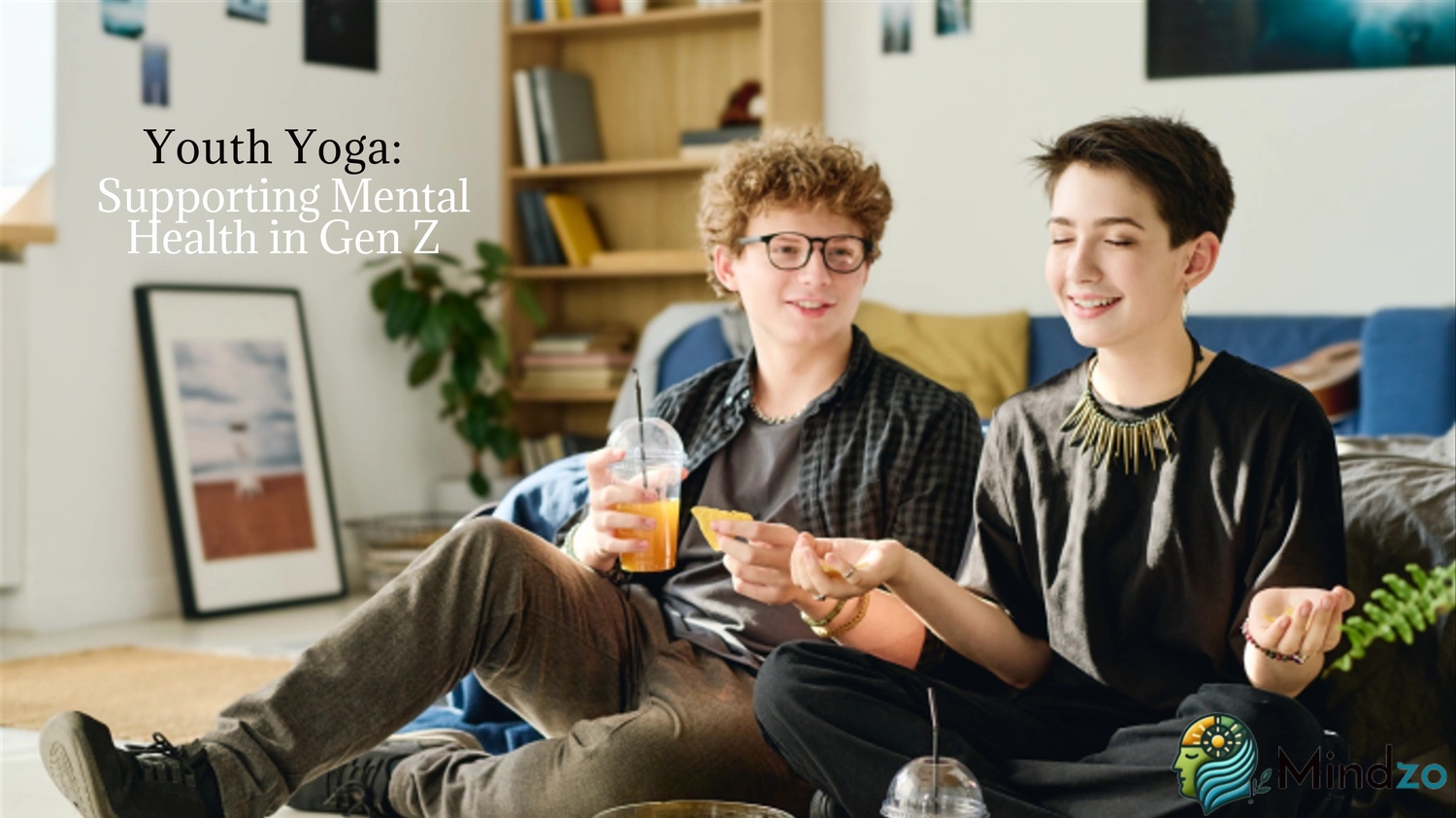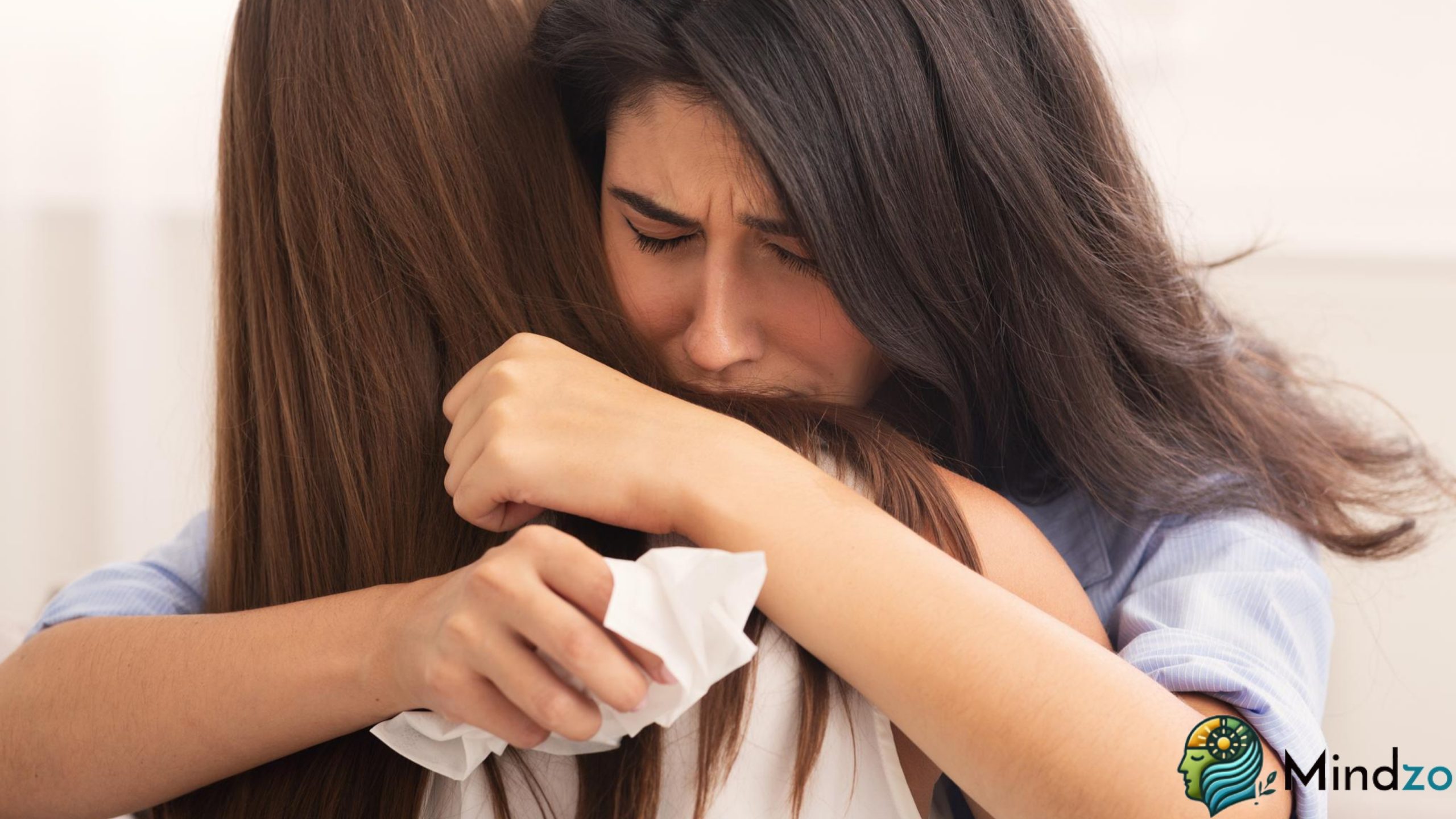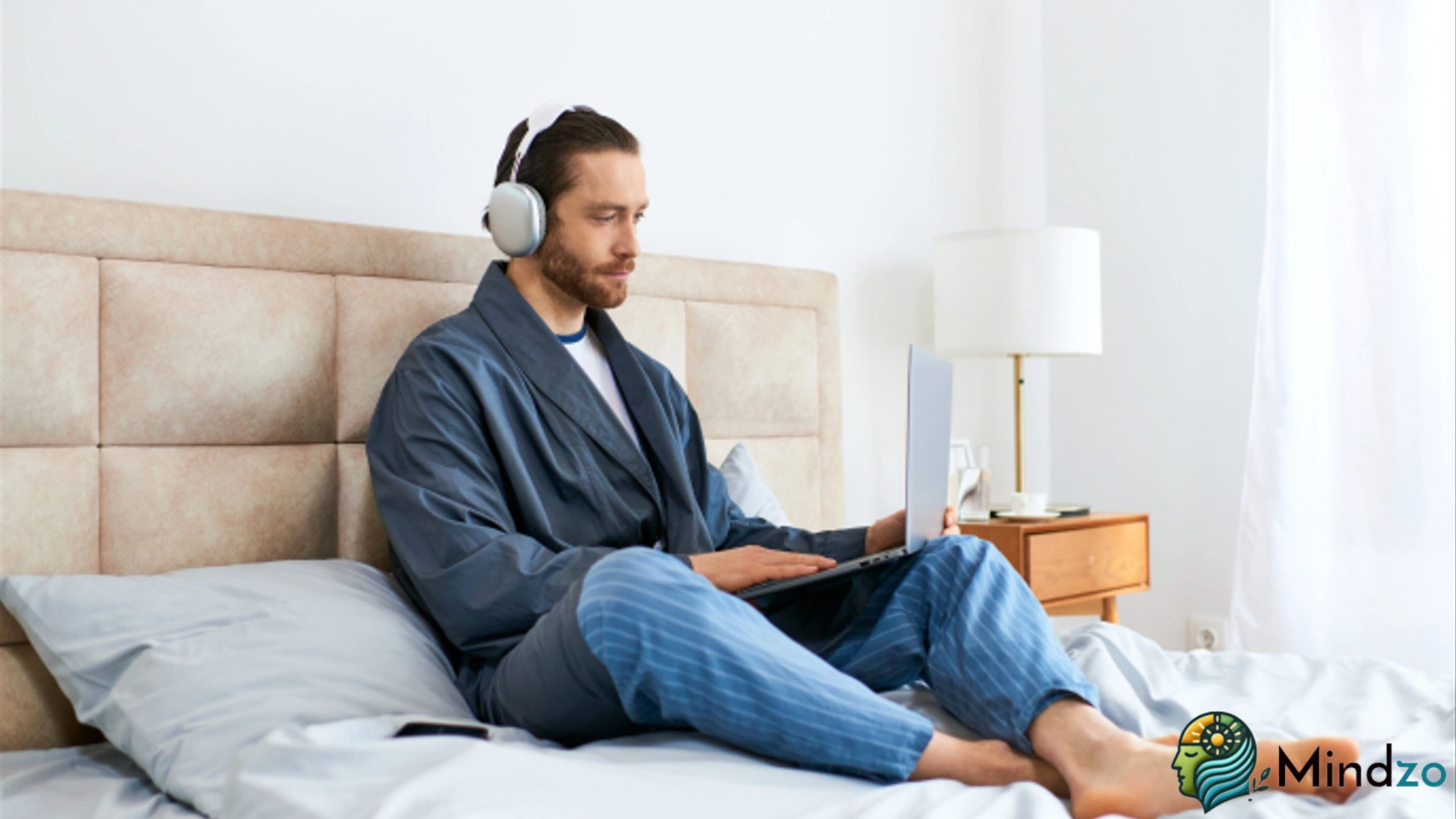Youth Yoga: Supporting Mental Health in Gen Z

Generation Z – roughly those born between 1997 and 2012 – is facing a mental health crisis unlike anything previous generations experienced at their age. Recent surveys reveal that 46% of Gen Z has received a mental health diagnosis, while 42% struggle with depression and 61% have been diagnosed with anxiety. These aren’t just statistics – they represent millions of young people navigating unprecedented challenges in an increasingly complex world.
Yet here’s something remarkable: Gen Z is also the most open generation about mental health, actively seeking solutions and refusing to suffer in silence. They’re reshaping how we think about wellness, demanding accessible tools that fit their lives, and embracing practices that previous generations might have dismissed. Enter yoga – a practice that’s gaining traction among young people not as some trendy fitness fad, but as a legitimate mental health tool backed by science and validated by their own experiences.
Why Gen Z Needs Different Mental Health Tools
Understanding why yoga resonates with Gen Z requires understanding what makes this generation’s mental health challenges unique. This isn’t about weakness or being “too sensitive” – it’s about coming of age in a fundamentally different world.
The Digital Native Dilemma: Gen Z is the first generation to grow up entirely in the smartphone era. Social media shapes identity formation, comparison culture is constant, and the pressure to curate a perfect online persona creates anxiety that previous generations never faced. The result? A disconnect between physical presence and digital existence that leaves many young people feeling simultaneously hyperconnected and profoundly isolated.
Climate Anxiety and Global Uncertainty: Unlike older generations who learned about world problems from evening news, Gen Z has watched climate disasters, political turmoil, and global crises unfold in real-time on their phones since childhood. The weight of inheriting a troubled world creates a unique form of existential anxiety.
Academic and Economic Pressure: Skyrocketing college costs, crushing student debt, housing unaffordability, and an uncertain job market create stress that starts in middle school and intensifies through young adulthood. The pressure to succeed academically while facing an unclear future is exhausting.
The Pandemic Generation: Many Gen Z members spent crucial developmental years – middle school, high school, or early college – in isolation during COVID-19. This disruption to social development, education, and milestone experiences has lasting effects.
What does all this mean for mental health interventions? Gen Z needs tools that:
- Work quickly and can be accessed anywhere
- Don’t require extensive time commitments
- Address both physical and mental symptoms simultaneously
- Feel authentic rather than performative
- Provide agency and control in an uncertain world
Yoga checks all these boxes – and research is proving it works.
The Science Behind Youth Yoga
Unlike many wellness trends popular on social media, yoga has substantial scientific backing, particularly for young people. Let’s look at what research actually demonstrates about yoga for youth mental health.
Studies reveal that combining postures with breath work significantly improves self-concept in school-aged children, with the combined approach showing the most improvement. This matters because self-concept – how you view and value yourself – is foundational to mental health.
Research on school-based yoga programs shows consistent benefits. Yoga provides unique factors beyond simple exercise through poses that demand focus and balance, plus coordination with breath. This combination engages both body and mind in ways that traditional exercise alone doesn’t achieve.
Perhaps most impressively, studies comparing movement-focused and breath-focused yoga found that both reduced stress parameters, but breath-focused yoga specifically improved sustained attention. For a generation struggling with focus in an age of constant distraction, this is significant.
The research consistently shows yoga helps young people with:
- Reduced anxiety and stress
- Improved mood and emotional regulation
- Better sleep quality
- Enhanced attention and focus
- Increased self-esteem and body image
- Greater stress resilience
These aren’t minor improvements – they’re the exact mental health challenges plaguing Gen Z.
Breath Work
If you only learn one thing from yoga, make it breath work. Unlike physical poses that require space, time, and sometimes privacy, breathwork is the ultimate stealth mental health tool. You can practice in class, at work, during a panic attack in a bathroom, or lying in bed at 3 AM when anxiety won’t let you sleep.
Why Breathing Matters for Gen Z Mental Health
Your breath is the only part of your autonomic nervous system – the system controlling stress response – that you can directly control. When anxiety spikes, your breathing becomes rapid and shallow, triggering more anxiety in a vicious cycle. Intentional breathing interrupts this cycle, literally switching your nervous system from “threat mode” to “safe mode.”
For Gen Z dealing with constant low-level anxiety punctuated by acute stress spikes, breathwork provides an always-available reset button.
Your Go-To Anxiety Killer
This technique, sometimes called “natural tranquilizer,” is perfect when you’re spiraling into anxiety or can’t shut off your mind.
How to practice:
- Exhale completely through your mouth (make a whoosh sound)
- Close your mouth and inhale quietly through your nose for 4 counts
- Hold your breath for 7 counts
- Exhale completely through your mouth for 8 counts (whoosh sound)
- Repeat 3-4 cycles
When to use it:
- Before exams or presentations
- During panic attacks
- When you can’t fall asleep
- Before difficult conversations
- When doomscrolling triggers anxiety
The extended exhale activates your parasympathetic nervous system, creating genuine calm within minutes. No app required, no equipment needed, works every time.
Box Breathing
Navy SEALs use this technique before high-stress missions. If it works for combat situations, it works for your life.
How to practice:
- Inhale for 4 counts
- Hold for 4 counts
- Exhale for 4 counts
- Hold empty for 4 counts
- Repeat for 2-5 minutes
When to use it:
- Before job interviews or college visits
- When you’re overwhelmed by multiple stressors
- During test anxiety
- When social anxiety feels overwhelming
- Anytime you need to feel grounded and in control
The equal timing creates balance and the counting gives your anxious mind something to focus on besides worries.
Brain Balancer
This one looks weird, but the research on its effectiveness for anxiety and focus is solid. It balances the left and right hemispheres of your brain while calming your nervous system.
How to practice:
- Use your right thumb to close your right nostril
- Inhale through your left nostril
- Use your ring finger to close your left nostril, release your thumb
- Exhale through your right nostril
- Inhale through your right nostril
- Close right nostril with thumb, release ring finger
- Exhale through left nostril
- That’s one round – do 5-10 rounds
When to use it:
- When you need to focus for studying or creative work
- Before bed when your mind is racing
- When you’re feeling emotionally imbalanced
- During depression when everything feels flat
- Anytime you need mental clarity
The Bee Breath: Instant Anxiety Relief
This technique creates internal vibrations that physically calm your nervous system. Yes, you hum like a bee. Yes, it feels silly. Yes, it absolutely works.
How to practice:
- Take a deep breath in
- As you exhale, make a humming sound like “mmmm” or “nnnn”
- Feel the vibration in your head and chest
- Repeat 5-10 times
When to use it:
- During overwhelming anxiety or panic
- When intrusive thoughts won’t stop
- Before sleep when your mind is spinning
- When you’re angry and need to calm down quickly
- In the shower or car where no one hears you
The vibration literally interrupts anxiety pathways in your brain. It’s scientifically validated sound therapy you create yourself.
Movement Practices That Actually Resonate
Let’s be honest – traditional yoga classes can feel inaccessible, expensive, or culturally alienating for many young people. The good news? You don’t need fancy studios, expensive clothes, or pretzel-level flexibility to benefit from the yoga movement. Here’s how to make it work for real life.
The Morning Reset: 5 Minutes to Change Your Day
Most Gen Z members wake up and immediately check their phones, starting the day in reactive mode. This five-minute sequence interrupts that pattern and sets a different tone.
The Sequence:
- Before looking at your phone, sit on the edge of your bed
- Take 10 deep breaths, making exhales longer than inhales
- Stand and reach arms overhead, stretching tall (hold 5 breaths)
- Fold forward, letting your head hang (hold 8 breaths)
- Come to hands and knees, do 10 cat-cow movements (arch and round your spine)
- From hands and knees, press back to a resting pose (hold 10 breaths)
- Sit back up, set one intention for your day
That’s it. Five minutes before touching your phone literally changes your brain’s state before encountering digital stressors.
The Study Break Flow: Counteracting Screen Posture
Hours hunched over laptops or phones create physical tension that amplifies mental stress. This sequence undoes that damage in under 10 minutes.
The Sequence:
- Stand and do 5 shoulder rolls backward (slowly)
- Clasp hands behind back, lift chest, squeeze shoulder blades (hold 8 breaths)
- Reach one arm up, lean to the opposite side (hold 5 breaths each side)
- Stand on one leg for 30 seconds (repeat other side) – yes, balance counts as yoga
- Hands and knees, alternate reaching opposite arm and leg (10 times each side)
- Downward dog shape or standing forward fold (hold 8 breaths)
- Slow roll up to standing, pause and breathe (5 breaths)
Set a timer to do this every 90 minutes when studying or working. Your back, neck, and brain will thank you.
The Social Anxiety Survival Flow: Pre-Event Grounding
Social situations can trigger intense anxiety for many Gen Z members. This sequence grounds you before parties, meetings, or any social situation that feels overwhelming.
The Sequence:
- Find a private space (bathroom, car, empty room)
- Stand with feet wide, toes turned slightly in (hold and breathe for 10 breaths)
- Squat down low and rest, or sit on floor if that’s easier (hold 10 breaths)
- Come to hands and knees, do slow cat-cow movements (10 times)
- Child’s pose – forehead on floor, arms extended (hold 15 breaths)
- Lie on back, hug knees to chest (hold 10 breaths)
- Still on back, extend legs up a wall if available, or straight up (hold 2 minutes)
This sequence literally lowers your heart rate and cortisol levels while giving you something concrete to focus on besides anxiety.
The Anger Release Flow
Gen Z faces a lot of legitimate anger – climate inaction, systemic injustices, economic unfairness. This sequence helps process anger physically rather than letting it turn inward into depression or outward into unhealthy expressions.
The Sequence:
- Stand with feet wide, bend knees, and punch forward (alternate arms, 20 times)
- Stand tall, sweep arms up forcefully while inhaling, down forcefully while exhaling (10 times)
- Warrior-type lunge position, reach arms forward and pull back like rowing (10 times each side)
- Forward fold, let yourself sigh or make sounds while hanging (10 breaths)
- Twist seated or standing – each direction (10 breaths each)
- Lie down flat on back, progressive muscle relaxation (tense and release each body part)
- Final rest – just lie there and breathe (2-5 minutes)
This transforms emotional energy into physical expression in a way that actually resolves it rather than suppressing or explosively releasing it.
The Bedtime Wind-Down
Sleep issues plague Gen Z more than any previous generation, often due to racing thoughts and phone usage before bed. This sequence done IN bed helps transition to sleep.
The Sequence:
- Lie on your back, place one hand on belly and one on chest
- Breathe deeply, feeling belly rise and fall (2 minutes)
- Hug both knees to chest, rock gently side to side (10 times)
- Let knees fall to one side, arms extended opposite direction (hold 2 minutes each side)
- Legs up the wall (or against headboard), or if that’s awkward, just legs straight up (hold 5 minutes)
- Return to back, arms by sides, palms up
- Progressive body relaxation: tense and release each body part from toes to head
- Remain still and follow your breath until you fall asleep
Research shows this type of practice improves both sleep onset and quality. It works by physically signaling to your body that it’s safe to rest.
Building a Practice That Sticks: Real Talk for Busy Lives
Let’s address reality: Gen Z schedules are packed with school, work, social obligations, and trying to maintain some semblance of self-care. Here’s how to actually make yoga stick without adding more pressure.
The Micro-Practice Philosophy
Forget the “you need to practice 60 minutes daily” nonsense. Research shows that consistency beats duration every time. Three minutes daily creates more neural pathway changes than 90 minutes once a week.
Anchor Your Practice: Link yoga to something you already do daily:
- Breathwork while your coffee brews
- Morning sequence before checking your phone
- Study break flow after every Pomodoro cycle
- Bedtime wind-down as part of your sleep routine
The habit-stacking approach makes practice automatic rather than something requiring motivation.
The Screenshot Strategy
Take screenshots of the sequences in this article or find ones online that resonate. Keep them in a dedicated phone folder called “Mental Health Tools” or whatever feels right. When anxiety hits, you have immediate visual guides – no app subscription needed, no internet required.
The Friend Accountability Model
Gen Z thrives on community. Find even one friend to text when you practice. “Just did bee breath before my presentation and actually feel okay.” That simple check-in creates accountability and normalizes the practice within your friend group.
The Data Track
If you’re motivated by tracking, note your mental state before and after practice on a 1-10 scale. Seeing concrete evidence that breathwork drops your anxiety from 8 to 4 reinforces the practice. But if tracking creates more anxiety, skip it – some of us need evidence, others just need to feel better.
The Zero-Judgment Zone
Some days you’ll practice for 20 minutes. Some days you’ll manage three breaths before your alarm goes off again. Some weeks you’ll forget completely. All of it is fine. Yoga isn’t another thing to feel guilty about failing at – it’s a tool available whenever you remember to use it.
Addressing Common Gen Z Barriers to Yoga
Let’s tackle the real reasons young people often don’t try yoga or quit quickly.
“I’m not flexible”: Flexibility is a result of yoga, not a requirement. If you can breathe, you can do yoga. The breathwork is more important than the poses anyway.
“It’s too expensive”: Free YouTube yoga videos specifically for teens and young adults are everywhere. Start there. Zero cost, zero commitment.
“It seems culturally appropriative”: This is a valid concern. Look for teachers who acknowledge yoga’s roots in Indian philosophy, who don’t just treat it as exercise, and who teach with respect rather than commodification. Using the practices for genuine mental health doesn’t erase the culture – ignoring its origins does.
“I don’t have time”: You have time to scroll social media, which means you have time for three minutes of breathing. It’s about priority, not time availability.
“It feels performative/fake”: Fair. Some yoga culture is Instagram-worthy bullshit. But the actual practices – the breathing techniques and movements – are scientifically validated interventions for anxiety and depression. Skip the performative stuff, use the tools that work.
“My mind won’t stop during meditation”: That’s literally the point. Your mind won’t magically go quiet. The practice is noticing when it wanders and gently returning to breath. That noticing-and-returning IS the meditation.
When Yoga Isn’t Enough: Knowing Your Limits
Here’s crucial information: yoga is a mental health support tool, not a mental health treatment. It helps manage symptoms and build resilience, but it doesn’t replace therapy or medication when those are needed.
Seek professional help if you experience:
- Persistent thoughts of self-harm or suicide
- Inability to function in school, work, or relationships
- Symptoms that worsen despite self-care efforts
- Substance use to cope with mental health symptoms
- Trauma that needs processing with a trained professional
Yoga can complement therapy and medication – research shows it enhances other treatments. But it’s one tool in a comprehensive approach, not a complete solution on its own.
The Gen Z Advantage: Redefining Mental Health
Here’s what’s remarkable about Gen Z: you’re destigmatizing mental health in ways previous generations never did. You talk openly about therapy, compare anxiety symptoms like comparing notes on homework, and refuse to suffer in silence. This openness is revolutionary.
Yoga fits perfectly into this new mental health paradigm because it:
- Provides immediate agency over your nervous system
- Works alongside other treatments without conflict
- Costs nothing and requires no special equipment
- Can be practiced alone or communally
- Addresses both physical and mental symptoms
- Builds long-term resilience, not just temporary relief
You’re the generation that will integrate mental health care into daily life as naturally as physical hygiene. Yoga is one part of that integration – accessible, evidence-based, and effective.
Your Yoga, Your Way
The beauty of yoga for mental health is its flexibility – both literally and figuratively. There’s no one right way to practice. Your yoga might be five minutes of breathing in your car before school. It might be a full class at a studio. It might be following a YouTube video in your bedroom at midnight when panic hits.
All of it is valid. All of it helps. The practice meets you where you are, works with what you have, and grows with you over time.
Gen Z is facing unprecedented mental health challenges, but you’re also pioneering unprecedented solutions. Yoga – particularly breath work and mindful movement – is one evidence-based tool in your mental health toolkit. It’s not magic, it’s not a cure-all, but it is scientifically validated, immediately accessible, and genuinely effective.
Your mental health matters. The tools to support it are available. And one of the most powerful ones requires nothing but your breath, your body, and your willingness to try.
Roll out a mat, or don’t. Find a quiet space, or practice in chaos. Follow traditional sequences, or create your own. The only rule is this: breathe consciously, move mindfully, and be patient with yourself.
Your generation is changing the conversation about mental health. Yoga is simply one more way you’re taking control of your wellbeing in a world that often feels out of control.
Resources:
- https://www.ncbi.nlm.nih.gov/pmc/
- https://www.nih.gov
- https://www.aecf.org
- https://www.sciencedirect.com
- https://www.frontiersin.org
- https://www.health.harvard.edu
-
 Beyond Words: The Emotional Medicine of a Simple HugOctober 27, 2025
Beyond Words: The Emotional Medicine of a Simple HugOctober 27, 2025 -
 Music’s Unique Therapeutic BenefitsOctober 23, 2025
Music’s Unique Therapeutic BenefitsOctober 23, 2025

Leave a Reply